I am pleased to have Shantel Gardner, a descendant of Emma and Joseph Smith, share today’s post for Emma Smith’s Birthday celebration. Shantel has spent years studying Emma and I’ve loved reading her insights into Emma’s life. She shares so many little tidbits about Emma that I’ve never heard before. Hope you enjoy it and don’t forget about the present for Emma this Sunday, July 1oth!
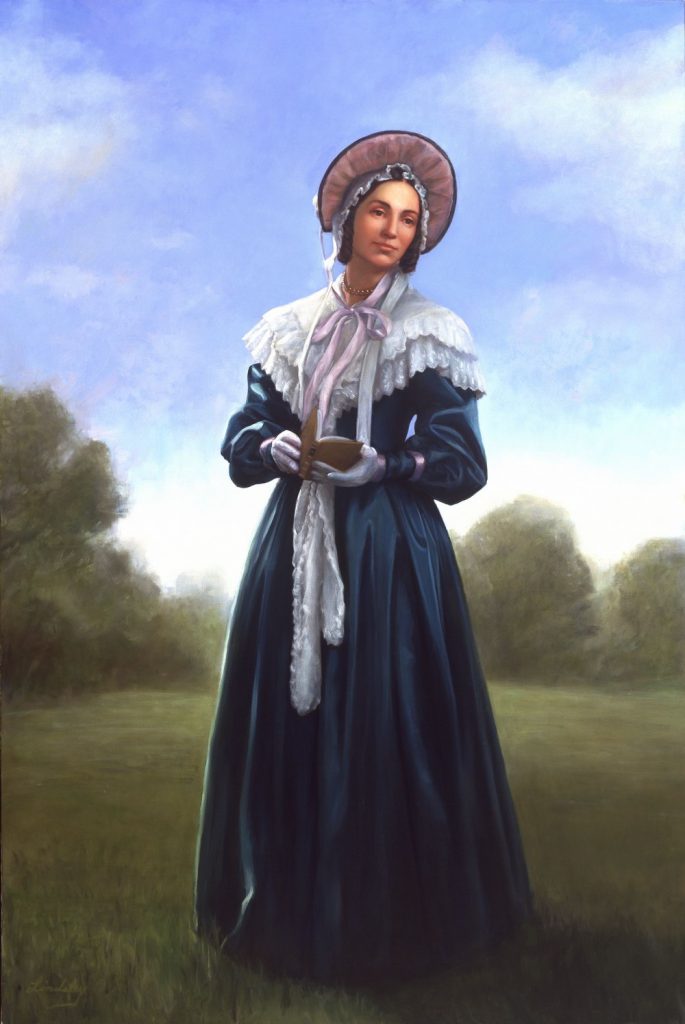
“Sister Emma” by David Lindsley
Image Source
Emma Hale was born July 10, 1804 in Harmony, Pennsylvania. In her early years her family would have been quite poor and it wasn’t until her father bought an inn and starting running it when she was older that they would have had the money to own horses and boats. She was a very skilled horsewoman and loved to canoe on the river. She was sent away to boarding school for a year and so she was qualified to be a teacher. She was 5’9″ and described as “big boned”. In fact when the Reorganized Church of Jesus Christ of Later-days Saints (RLDS) hunted for the graves of Joseph and Hyrum, years after their deaths, they also found Emma’s grave. They were surprised to find her as big in stature as Joseph. She had dark brown hair, brown eyes, and an olive complexion. A man staying at her father’s inn said she was beautiful and “well-turned” which is very old-fashioned expression for having a good figure. Even though her father did not consider himself to be a Christian she was religious from a very young age and when she was six-years-old father once found her praying on his behalf and it moved him so much that he later embraced Christianity. She is usually depicted as praying in a barn but further research has shows that she was mostly like in the woods praying– just like Joseph did. This was important event to Emma, it was one of her first personal experiences with the Lord answering a prayer.
Joseph Smith was about 6 feet tall and had brownish-blonde hair and bright blue eyes. He was considered very handsome. He said that when he saw Emma it was love at first sight. There is an account given by Newell Knight that when his older brother Alvin died Joseph went to the Lord and asked him who would help him get the plates, now that Alvin was gone, and the Lord told him “you will know”. When Joseph first saw Emma, the spirit confirmed to him that it was her and that she was to help him get the plates and translate them. Joseph asked her father for her hand three times and he said no every time. So they eloped.
Women had nothing in the 1820’s, no voting rights, no property rights, no access to education easily, they could not divorce, and the very identity of a woman was based on who her male counterpart was. Abuse and neglect was common and a woman’s chances of survival greatly diminished depending on who she married. Emma was raised differently than most women of the day. She was educated, outspoken, she had opinions and she voiced them. She could hold her own in a conversation with a man, and that was highly unusual. Her father took careful measures to make sure Emma had more advantages than most women, and the idea that she was going to marry a dirt farmer of no consequence, who was claiming to see angels and translating gold records, was terrifying to him. She had a quick wit, which is one of the things that attracted Joseph to her, but I really have sympathy for her father. The chances for her happiness and well being were, in his mind, gone if she married Joseph. In fact he once told Joseph, “You have stolen my daughter and married her, I would have rather have seen her to her grave.” As a result of their elopement Emma’s father disowned her. Even though Emma and Joseph would later live with the Hale family for a period of time Emma’s family never embraced the gospel and her relationship with them was always strained. When she left with Joseph to go to Ohio she left her family behind… never to see them again. This was a huge sacrifice for her but only one of the numerous ones she made for the restoration.
Emma’s father was right in some regard because Emma and Joseph never had it easy. They lost their first son, whom they named Alvin, in June of 1828 and would gone on to loose five more in the coming years. In addition, Joseph was arrested and involved in over 225 court cases during their marriage. Even so, Emma was baptized on June 28, 1830 in Colesville, New York along with several other saints, including Newell Knight. On the day of the baptism Newell Knight’s farm and fields were burned and Joseph was arrested for “disorderly conduct”. As a result Emma had to wait two months before she could be confirmed. After Joseph returned he confirmed her and it was during her confirmation that he received section 25 of the D&C which specifically speaks about Emma’s mission and role in the gospel.
Image Source
Due to persecution Joseph and Emma moved with the church to Kirkland, Ohio in April 1831. It was there that Emma gave birth to twins– Thaddeus and Louisa– who died soon after birth. John Murdock, another member of the church, lost his wife in childbirth that same day and since he already had children to look after he gave his newborn twins to Joseph and Emma to care for. Joseph and Emma named them Joseph and Julia and Emma told John Murdock to never see the twins or tell them that he was their father. One of the twins, Joseph, died several months later when in Hiram, Ohio the door was left open during a mob raid in which Joseph Smith was tared and feathered. Emma was devastated but felt like she giving little Joseph back to his mother.
Not long after little Joseph’s death Joseph and Newell Whitney had to travel to Missouri on church business. Joseph sent Emma up to Kirtland from Hiram to stay with the Whitney while he was gone. She was pregnant again and had Julia. When she arrived in Kirtland and knocked at the door of Elizabeth Whitney Elizabeth’s aunt, Sarah Whitney who was strongly anti-Mormon, answered the door and told Emma that Elizabeth was sick and that there was no room for her there. She sent Emma away without Elizabeth’s knowledge. As a result Emma was homeless in Kirtland for three months, staying with different families for one or two days, while waiting for Joseph to return.
Eventually persecution drove the Saints out of Kirtland and Emma traveled 900 miles by herself with small children to Far West, Missouri. In Far West the Saints faced further persecution and Emma’s home was ransacked three times and she lost everything. When she and her family were forced to flee Far West all she had was one blanket for her and her children to share. She took Joseph’s manuscripts of his translation of the Bible and placed them in sacks under the layers of her petticoats. She was afraid that she would be raped (which had happened to many LDS women in Far West) and wanted to make sure that the manuscript would not be discovered. With the manuscript hidden away she and her children walked across the frozen Missouri river, with ice breaking beneath her feet, to safety in Quincy, Illinois.
In 1839 The Saints finally found refuge in a swampy part of Missouri they named Nauvoo. Emma was a midwife and learned how to use herbs and medicines from her mother. People would come from all over to have her help them with various illnesses. Her skills came in handy in Nauvoo because malaria was rampant and many people died from it.
Among those who died from malaria was Emma’s youngest son Don Carlos (named after another of Joseph’s brothers) who died when he was only 14 months old. Emma said that out of all the babies she lost Don Carlos was the hardest for her to loose.
Nauvoo would be Emma’s home for the remainder of her life, but her life there is often the topic of much confusion. Part 2 of my post will address some of the misconceptions and myths that surround her later life.
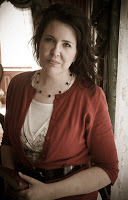 Shantel Gardner lives in Minnesota with Joel, her husband of 15 years, and their five children. She has dedicated years of her personal study to Church history research, with a special interest in Joseph and Emma. She is a committee member of the Joseph Smith Jr. and Emma Hale Smith Historical Society and is assisting with ongoing projects. She is herself a descendant through Joseph’s family line. Shantel has a background in theatre and was a Deseret Cultural Arts Award finalist in 2009 for her play called “Brother Joseph”. She has also written other plays for the Cultural Arts department of the Church. Since 2005, Shantel has been invited to speak about Emma Smith across the country. She is currently pursuing a degree in Religious Studies at the University of Minnesota.
Shantel Gardner lives in Minnesota with Joel, her husband of 15 years, and their five children. She has dedicated years of her personal study to Church history research, with a special interest in Joseph and Emma. She is a committee member of the Joseph Smith Jr. and Emma Hale Smith Historical Society and is assisting with ongoing projects. She is herself a descendant through Joseph’s family line. Shantel has a background in theatre and was a Deseret Cultural Arts Award finalist in 2009 for her play called “Brother Joseph”. She has also written other plays for the Cultural Arts department of the Church. Since 2005, Shantel has been invited to speak about Emma Smith across the country. She is currently pursuing a degree in Religious Studies at the University of Minnesota.


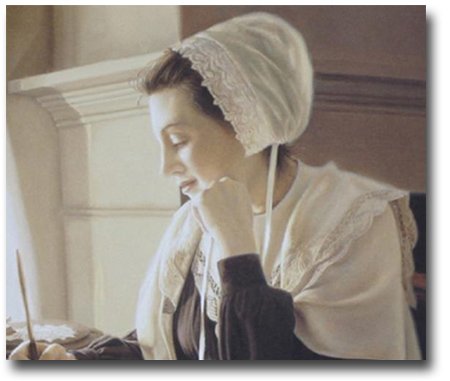
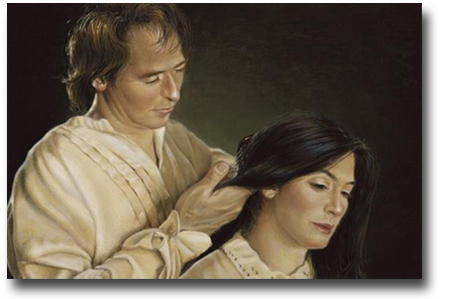
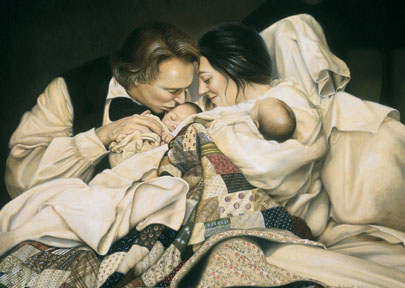
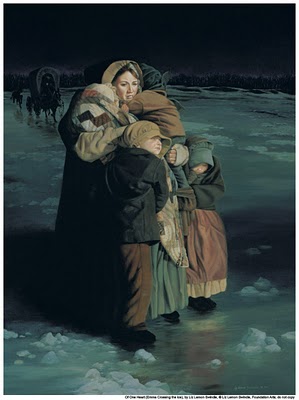

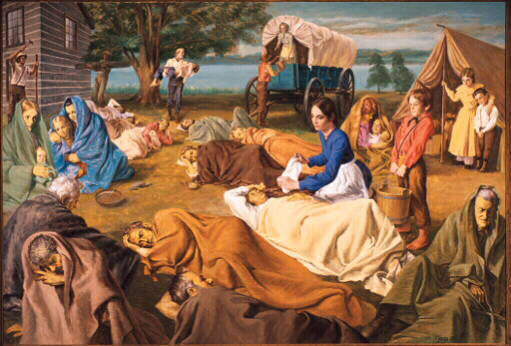






Thank you so much for this post. I love it.
When I was investigating the Church of Jesus Christ of LDS not too long ago,I challenged the missionarys to tell me the story of Joseph Smith for real. So they took me down to the Visitors Center and we watched the movie Joseph Smith Prophet of the Restoration.
From the beginning to the end, I felt as if I was "there" in the lives of Joseph and Emma. My heart broke for them as they struggled in their marriage and with the building of this church. What convinced me that this church is "true" was the love. The love between Joseph and Emma; and Jospeh for the church, and the love our Heavenly Father had for Joseph and Emma. I decided right there to get baptized. I was given a gift of 2 books about Emma Smith and I love them.
Love this idea of celebrating Emma's birthday! She is definitely one of my heroes.
I enjoyed reading this post, Shantel! One thing I never thought of or heard before was Emma feeling like she was giving little Joseph back to his mother. Beautiful.
Having the pleasure of personally knowing Shantel….I feel like I've been blessed to personally know Emma Smith better.
Thank you for being you Shantel. I truly believe that Emma Smith peacefully smiles every time you share your testimony of her with the world.
Thanks for this first part! I look forward to reading the second installment. I hope you'll touch on Emma's response to polygamy, how it impacted her marriage and her life when Joseph was sealed to other women. I know the facts can be fuzzy when we get into anything that happened so long ago, and I know there's controversy surrounding Emma in this area, but I'd love any insight you can provide. From the little I know of her life, any biographical sketch of Emma that doesn't address plural marriage is really missing a piece of the puzzle.
I enjoyed both of your posts about Emma.
I had never heard that Emma was a midwife. I would love to hear more about that. Where can I find more info?
I recently discovered a book, written by Kimberly J. Smith, a member if the Church and second great-granddaughter to Emma and Joseph and from the Smith family who stayed in Nauvoo, rather than coming west with the Saints.The name is "Rising Hills and Sinking Valleys" and can be ordered through Deseret Book. It gives insights to information that only the Smith family would know and answers so many questions that only members of the Smith family would know through her family research.